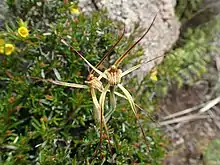Caladenia caesarea subsp. maritima
Caladenia caesarea subsp. maritima, commonly known as the cape spider orchid, is a plant in the orchid family Orchidaceae and is endemic to the south-west of Western Australia. It has a single spreading, hairy leaf and up to three small mustard-coloured flowers with red stripes. It is only known from a small coastal area near Cape Leeuwin where it grows in clumps of ten or more.

| Cape spider orchid | |
|---|---|
 | |
| Caladenia caesarea subsp. maritima growing near Dunsborough | |
| Scientific classification | |
| Kingdom: | Plantae |
| Clade: | Tracheophytes |
| Clade: | Angiosperms |
| Clade: | Monocots |
| Order: | Asparagales |
| Family: | Orchidaceae |
| Subfamily: | Orchidoideae |
| Tribe: | Diurideae |
| Genus: | Caladenia |
| Species: | C. caesarea |
| Subspecies: | C. c. subsp. maritima |
| Trinomial name | |
| Caladenia caesarea subsp. maritima | |
Description
Caladenia caesarea subsp. maritima is a terrestrial, perennial, deciduous, herb which often occurs in clumps of ten or more. It has an underground tuber and a single erect, hairy leaf 6–9 cm (2–4 in) long and 2–4 mm (0.08–0.2 in) wide. There are up to three flowers borne on a stem 15–20 cm (6–8 in) high and each flower is 4–5 cm (1.6–2.0 in) long and 5–6 cm (2.0–2.4 in) wide. The lateral sepals and petals are spread widely. The labellum is mustard-yellow with brownish-red stripes, projects prominently, has an irregularly serrated edge and two rows of shiny yellow calli along its centre. Flowering occurs from August to mid-September and is followed by a non-fleshy, dehiscent capsule containing a large number of seeds.[2][3][4]
Taxonomy and naming
Caladenia caesarea was first formally described by Karel Domin in 1912 and given the name Caladenia filamentosa subsp. caesarea. Domin's description was published in Journal of the Linnean Society, Botany[5][6] but in 1989 Mark Clements and Stephen Hopper raised it to species status.[7][8] In 2001 Hopper and Andrew Brown described three subspecies, including subspecies maritima and the descriptions were published in Nuytsia.[1] The epithet (maritima) is a Latin word meaning "of the sea",[9] referring to the "coastal habitat of this species".[2]
Distribution and habitat
Cape spider orchid occurs in the south-west corner of Western Australia between Dunsborough and Cape Leeuwin in the Jarrah Forest biogeographic region where it grows in shallow soil on granite outcrops.[2][3][10][11] It is endemic to Meelup Regional Park.[12]
Conservation
Caladenia caesarea subsp. maritima is classified as "endangered" under the Environment Protection and Biodiversity Conservation Act 1999 and as "rare flora" under the Western Australian Wildlife Conservation Act 1950. An interim recovery plan has been prepared for this subspecies.[10][13]
References
- "Caladenia caesarea subsp. maritima". APNI. Retrieved 1 November 2016.
- Brown, Andrew; Dixon, Kingsley; French, Christopher; Brockman, Garry (2013). Field guide to the orchids of Western Australia : the definitive guide to the native orchids of Western Australia. Simon Nevill Publications. p. 54. ISBN 9780980348149.
- Hoffman, Noel; Brown, Andrew (2011). Orchids of South-West Australia (3rd ed.). Gooseberry Hill: Noel Hoffman. p. 76. ISBN 9780646562322.
- "Caladenia". Royal Botanic Gardens Victoria. Retrieved 1 November 2016.
- "Caladenia filamentosa subsp. caesarea". APNI. Retrieved 31 October 2016.
- Domin, Karel (1912). "Flora of Western and North-Western Australia". Journal of the Linnean Society, Botany. 41: 251. Retrieved 31 October 2016.
- "Caladenia caesarea". APNI. Retrieved 31 October 2016.
- Clements, Mark Alwyn; Hopper, Stephen (1989). "Catalogue of Australian Orchidaceae". Australian Orchid Research. 1: 21.
- Brown, Roland Wilbur (1956). The Composition of Scientific Words. Washington, D.C.: Smithsonian Institution Press. p. 689.
- "Caladenia caesarea subsp. maritima". FloraBase. Western Australian Government Department of Parks and Wildlife.
- Paczkowska, Grazyna; Chapman, Alex R. (2000). The Western Australian flora : a descriptive catalogue. Perth: Wildflower Society of Western Australia. p. 76. ISBN 0646402439.
- "Flora & Vegetation". Meelup Park. Retrieved 5 October 2019.
- Douglas, Craig; Liddelow, Janine. "Cape spider orchid (Caladenia caesarea subsp. maritima) recovery plan" (PDF). Australian Government Department of the Environment. Retrieved 1 November 2016.
